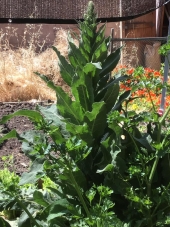

 9
9




Live, love life holistically
 9
9




Visit Redhawk's soil series: https://permies.com/wiki/redhawk-soil
How permies.com works: https://permies.com/wiki/34193/permies-works-links-threads












 5
5




Jay Angler wrote:Well, there's not doubt in my mind that Borage feeds the bees! Particularly in the late fall where I live, when there aren't so many other flowers.
However, I've never had a huge oversupply, so the only things I have done is chop some finely into soups, or added some to a mixed-greens pesto.
Live, love life holistically
 6
6




Invasive plants are Earth's way of insisting we notice her medicines. Stephen Herrod Buhner
Everyone learns what works by learning what doesn't work. Stephen Herrod Buhner

 10
10





- Tim's Homestead Journal - Purchase a copy of Building a Better World in Your Backyard - Purchase 6 Decks of Permaculture Cards -
- Purchase 12x Decks of Permaculture Cards - Purchase a copy of the SKIP Book - Purchase 12x copies of Building a Better World in your Backyard












 7
7




Timothy Norton wrote:I just want to post to share a bit of a laugh with you.
I too have had a problem growing borage! I bought a half pound of seed and sprinkled it all around my property and now am in the same boat as you!
Small world and an excellent topic to post about.
Live, love life holistically












 8
8




- Tim's Homestead Journal - Purchase a copy of Building a Better World in Your Backyard - Purchase 6 Decks of Permaculture Cards -
- Purchase 12x Decks of Permaculture Cards - Purchase a copy of the SKIP Book - Purchase 12x copies of Building a Better World in your Backyard












 10
10




Anne Miller wrote:Borage was on my property when I made my purchase. Since then I have seen none.
Since I have no experience cooking it I will say that I believe those plants are telling you something.
Planting by spreading out a 6” layer of compost helped the borage.
Live, love life holistically












 5
5




Timothy Norton wrote:I'm currently using the borage as a pollinator attractor near but not in my vegetable gardens. I also am hoping to use it as a form of green manure.
I have a good amount growing in some rocky soil that I have been pulling slate roofing chunks out of. It seems to be a never ending rock pile but the borage doesn't seem bothered. The hope is that it will assist in slowing down some invasive plants by competing for space.
Live, love life holistically
 13
13




 8
8




WARNING permaculture is highly addictive, it may cause life altering changes such as valuing people, community and resources, and promote respect, learning, support and kindness .
 10
10




Best luck: satisfaction
Greatest curse, greed
 5
5




 6
6




Anne Miller wrote:Borage was on my property when I made my purchase. Since then I have seen none.
Since I have no experience cooking it I will say that I believe those plants are telling you something.
Planting by spreading out a 6” layer of compost helped the borage.
$10.00 is a donation. $1,000 is an investment, $1,000,000 is a purchase.
 3
3




I am only one, but still I am one. I cannot do everything, but still I can do something; and because I cannot do everything, I will not refuse to do something that I can do. (E.E.Hale)
 4
4




Best luck: satisfaction
Greatest curse, greed
 4
4




 and then a few spoons of flour, plus some of the borage cooking water to make a sauce. Finally, cooked borage and fried potatoes on top.
and then a few spoons of flour, plus some of the borage cooking water to make a sauce. Finally, cooked borage and fried potatoes on top.

|
Oh, sure, you could do that. Or you could eat some pie. While reading this tiny ad:
Learn Permaculture through a little hard work
https://wheaton-labs.com/bootcamp
|






